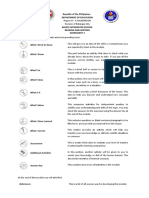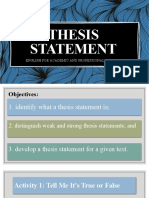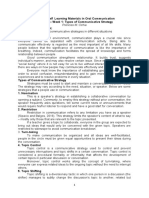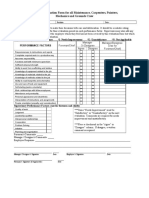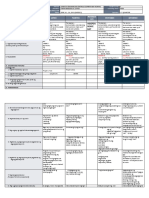0 ratings0% found this document useful (0 votes)
385 viewsOcc Long Quiz Reviewer
Occ Long Quiz Reviewer
Uploaded by
iesha limThis document discusses key concepts in communication including the communication process, aspects of communication like context and feedback, levels of communication from interpersonal to mass communication, principles of good communication, and models of communication. It also covers verbal and non-verbal communication, intercultural communication, and a developmental model of intercultural sensitivity.
Copyright:
© All Rights Reserved
Available Formats
Download as PDF, TXT or read online from Scribd
Occ Long Quiz Reviewer
Occ Long Quiz Reviewer
Uploaded by
iesha lim0 ratings0% found this document useful (0 votes)
385 views3 pagesThis document discusses key concepts in communication including the communication process, aspects of communication like context and feedback, levels of communication from interpersonal to mass communication, principles of good communication, and models of communication. It also covers verbal and non-verbal communication, intercultural communication, and a developmental model of intercultural sensitivity.
Original Description:
oral communications reviewer-- senior high school
Original Title
occ long quiz reviewer
Copyright
© © All Rights Reserved
Available Formats
PDF, TXT or read online from Scribd
Share this document
Did you find this document useful?
Is this content inappropriate?
This document discusses key concepts in communication including the communication process, aspects of communication like context and feedback, levels of communication from interpersonal to mass communication, principles of good communication, and models of communication. It also covers verbal and non-verbal communication, intercultural communication, and a developmental model of intercultural sensitivity.
Copyright:
© All Rights Reserved
Available Formats
Download as PDF, TXT or read online from Scribd
Download as pdf or txt
0 ratings0% found this document useful (0 votes)
385 views3 pagesOcc Long Quiz Reviewer
Occ Long Quiz Reviewer
Uploaded by
iesha limThis document discusses key concepts in communication including the communication process, aspects of communication like context and feedback, levels of communication from interpersonal to mass communication, principles of good communication, and models of communication. It also covers verbal and non-verbal communication, intercultural communication, and a developmental model of intercultural sensitivity.
Copyright:
© All Rights Reserved
Available Formats
Download as PDF, TXT or read online from Scribd
Download as pdf or txt
You are on page 1of 3
OCC Long Quiz Reviewer
• “…continuous because it continues to
THE COMMUNICATION PROCESS impact & influence future interactions &
Communication shape our relationships”
- process of creating & exchanging
meaning thru Symbolic Interaction • “communication skills can be learned
- constantly moves & changes because they can always be improved.”
- involves thoughts, ideas & understanding
5 LEVELS OF COMMUNICATION
5 ASPECTS OF COMMUNICATION 1.) INTRAPERSONAL
1. Context - occurs in your own mind
- people, occasion & task - “self-talk”
2. Physical Environment - basis of your feelings, biases
- actual space— or space where 2.) INTERPERSONAL
communication occurs - only between 2 people
3. Climate - we maintain relationships
- influences the emotional atmosphere 3.) SMALL GROUP
4. sender (encoding) → message → - communication w/i formal/informal
channel → receiver (decoding) → feedback groups
- Results in decision making, problem
→ channel → sender
solving & discussion
5. Feedback
- describes the receiver’s response/reaction to 4.) ONE to ONE GROUP
- speaker who seeks to inform, persuade &
the sender’s message
- helps the sender to determine how the motivate
receiver interpreted the message & how it 5.) MASS
can be improved - electronic/print & not face to face
- reach a large amt. of people/general public
5 PRINCIPLES OF GOOD
COMMUNICATION QUALITIES OF A GOOD
Communication is… COMMUNICATION
1. Ethical
• “…transactional because it involves an - follows the morals & codes of conduct w/i
exchange.” the society
: you have to give something & receive some
feedback for comm. to happen 2. Responsible
- takes responsibility for their own
• “…complex.” communication choices
: it is interactive & irreversible
: it is symbolic (open to interpretation) 3. Accessible
- they value positive relationships w/ peers,
supervisors & clients
• “… unavoidable because it is impossible
not to communicate” COMMUNICATION MODELS
LINEAR MODEL
-comm. as one way/ linear process
-speaker speaks & listener listens
- Lawsen’s (1948) model was based on 5
questions
: being vivid makes the conversation more
* speakers only speak but never listen (1 way) engaging
INTERACTIVE MODEL NON- VERBAL COMMUNICATION
- Schramm (1955) (2 way) - refers to an interview where behaviour is
- listener providing feedback to sender used to convey & represent ideas
- speaker of the message also listens to the
feedback Reasons for mastering NVC
* fails to show a dynamic process • enhances & emphasizes the message of
your speech
TRANSITIONAL MODEL • can communicate feelings, attitudes &
- communication that takes into account perceptions w/o needing to say a word
“noise” or interference
- default • can sustain the attention of listeners &
- has common ground keep them engaged in your speech
- ongoing & continuously changing
- interdependent • gives the audience a preview to the type of
speaker you are
VERBAL COMMUNICATION • makes you appear more dynamic/animated
in your deliver
- in which words are used to relay a message
for effective & successful communication,
use words to express ideas which can be • serves as a channel to release tension &
nervousness
easily used
*avoid highfaluting words • helps make your speech more dramatic
Qualities of Verbal Communication • can build a connection w/your listeners
Appropriateness
: language used must be appropriate to the • makes you a credible speaker
context & environment you are in
• helps you vary your speaking styles &
Brevity avoid a monotonous delivery
: simple yet precise words will make you
credible INTERCULTURAL COMMUNICATION
: be more direct w/your words - understand the importance of cultural
: avoid fillers background in communicative situations
- situated communication between
Clarity
individuals/ groups of diff. linguistic &
: it is easy for a listener to misinterpret your
cultural origins
words, feelings & idea - Considered as both a concept &
: hence, you should be clear
competence
Intercultural Competence
Ethics
- active possession of individuals of
: consider the gender, roles, ethnicity,
qualities which contribute to effective
preferences & status of the person you’re
communication
talking to
*knowledge, skills, attitude
- happens when individuals interact,
Vividness
negotiate and create meanings
- While bringing in their varied cultural STAGE 6
differences • Integration
- Can be viewed as comm. that is influenced - individuals start to go beyond their own
by various ethnicities, religions & sexual cultures & see themselves & their actions
orientations based on viewpoints
Tips to develop Intercultural Competence
• Research on the cultural background of
the person/group of people you’ll converse
with
• read, read & read
• Decode the body language of the other
person
• Look at positive stereotypes
Developmental Model of
INTERCULTURAL SENSITIVITY (DMIS)
by Bennett & Bennett
STAGE 1
• Denial
: individual does not recognize cultural
differences
STAGE 2
• Defense
: individual starts to recognize & is
intimidated by them (w/a superior or inferior
view of the culture)
STAGE 3
• Minimization
-although individuals see cultural
differences, they bank more on the
universality of idea
STAGE 4
• Acceptance
-individual begins to appreciate important
cultural differences in behaviours &
eventually in values
STAGE 5
• Adaptation
-individual is very open to world views when
accepting new perspectives
You might also like
- Lever - Structured Hiring 101 GuideDocument19 pagesLever - Structured Hiring 101 GuideMiralem BojicNo ratings yet
- Database Title Platform URL - IP Validated Access User Id & Password URL - Remote Access User Id & Password No. of Con. UsersDocument8 pagesDatabase Title Platform URL - IP Validated Access User Id & Password URL - Remote Access User Id & Password No. of Con. Userssadim22No ratings yet
- Course Description Professional CoursesDocument6 pagesCourse Description Professional CoursesHyman Jay Blanco67% (3)
- Lesson 2.1 Principles of Speech WritingDocument9 pagesLesson 2.1 Principles of Speech WritingCriselda Ann TabudlongNo ratings yet
- RW-Learning Activity Sheet 2Document11 pagesRW-Learning Activity Sheet 2William De VillaNo ratings yet
- Week 6 - Q1 Oral Com. SHS Module 5Document14 pagesWeek 6 - Q1 Oral Com. SHS Module 5John John BidonNo ratings yet
- G11SLM1-21st-Century-Literature Q1 SHSPHDocument25 pagesG11SLM1-21st-Century-Literature Q1 SHSPHLielanie NavarroNo ratings yet
- Eapp Module 3Document4 pagesEapp Module 3Alissa MayNo ratings yet
- Oral Com. Week 13-14Document11 pagesOral Com. Week 13-14asleahgumama6No ratings yet
- Lesson: Sample Oral Communication ActivitiesDocument14 pagesLesson: Sample Oral Communication ActivitiesdanelleNo ratings yet
- Oralcom Quarter2 Module 9 2.3Document8 pagesOralcom Quarter2 Module 9 2.3Albern Ray BaleanNo ratings yet
- R W Unit 1 - Lesson 1 - Definition and Purposes of DiscourseDocument26 pagesR W Unit 1 - Lesson 1 - Definition and Purposes of DiscourseLealyn OlunanNo ratings yet
- Acad - Writing Position PaperDocument11 pagesAcad - Writing Position PaperIrish Jane GalloNo ratings yet
- Shift in Speech ElementsDocument18 pagesShift in Speech ElementsWayne Dolorico MillamenaNo ratings yet
- Passed 1716-12-20MELCS-Baguio-Explaining Shifts in Speech ContextDocument18 pagesPassed 1716-12-20MELCS-Baguio-Explaining Shifts in Speech ContextRAISALAM MOHAMMAD100% (1)
- DAY 4PM Activity 3 Word PDFDocument25 pagesDAY 4PM Activity 3 Word PDFjoan tomarongNo ratings yet
- 2 - Q2 SHS Oral Comm Module 2Document21 pages2 - Q2 SHS Oral Comm Module 2Bryan BarreraNo ratings yet
- Week-5-Sample Oral Communication.Document39 pagesWeek-5-Sample Oral Communication.Maca UyagNo ratings yet
- Oralcom Quarter1 Module 5 Lesson2Document13 pagesOralcom Quarter1 Module 5 Lesson2Ronnalyn JalmascoNo ratings yet
- Summarizing and 7 Summarizing StrategiesDocument3 pagesSummarizing and 7 Summarizing StrategiesAngelyn ZamoraNo ratings yet
- OC LAS Q2 Wk6 MELC3Document10 pagesOC LAS Q2 Wk6 MELC3Marichu MarayanNo ratings yet
- Oral-Communications Q2 Module-3Document15 pagesOral-Communications Q2 Module-3Lee RichardNo ratings yet
- General Physics 1 12 Q2 M10Document15 pagesGeneral Physics 1 12 Q2 M10Secré.No ratings yet
- Week 4 - Q1 Oral Com. SHS Module 3Document15 pagesWeek 4 - Q1 Oral Com. SHS Module 3John John BidonNo ratings yet
- Lesson 4 Thesis StatementDocument23 pagesLesson 4 Thesis StatementLuisa CarpioNo ratings yet
- G11SLM10.2Q1 Oral Com Final For StudentDocument21 pagesG11SLM10.2Q1 Oral Com Final For Studentfaithpaderanga15No ratings yet
- Oral Communi in Contex Cation TDocument31 pagesOral Communi in Contex Cation TManelyn Taga100% (3)
- 21st Quarter 2 Week 2Document8 pages21st Quarter 2 Week 2John Brylle UrsuaNo ratings yet
- OralComm11 Q2 Module1 PrintDocument12 pagesOralComm11 Q2 Module1 PrintAbegail Panang0% (1)
- Oral Communication - Q2 - M4Document15 pagesOral Communication - Q2 - M4miki08mawsNo ratings yet
- Activity Sheets: Quarter 2 - MELC 6Document7 pagesActivity Sheets: Quarter 2 - MELC 6MARIBETH BABANo ratings yet
- 3 Q1-PerDevDocument28 pages3 Q1-PerDevRANYAH GANDARUZANo ratings yet
- Q2 Oral Communication in Context Module 3 Principles of Effective Speech WritingDocument21 pagesQ2 Oral Communication in Context Module 3 Principles of Effective Speech WritingNecil Abiso PaderanNo ratings yet
- NegOr Q3 EAPP Module7 v2-1Document27 pagesNegOr Q3 EAPP Module7 v2-1bdominicjohn95No ratings yet
- Oral Com Module 5Document9 pagesOral Com Module 5Christian Grace CatipayNo ratings yet
- Function of CommunicationDocument2 pagesFunction of Communicationandrie eugenioNo ratings yet
- DISS - Mod7 - Dominant Approaches and Ideas of Social Sciences Psychoanalysis and Rational ChoiceDocument16 pagesDISS - Mod7 - Dominant Approaches and Ideas of Social Sciences Psychoanalysis and Rational Choicejames carlo banzuelaNo ratings yet
- Oralcom Quarter2 Module 9 2.2Document8 pagesOralcom Quarter2 Module 9 2.2Albern Ray BaleanNo ratings yet
- Understanding Culture, Society and Politics: Quarter 2 - Module 7: State and Non-State InstitutionsDocument22 pagesUnderstanding Culture, Society and Politics: Quarter 2 - Module 7: State and Non-State InstitutionsMaharot GamerNo ratings yet
- General Mathematics: Department of EducationDocument15 pagesGeneral Mathematics: Department of EducationJasper Pangilayan OrañolaNo ratings yet
- SHS Lit Q2 Module4 WK4Document21 pagesSHS Lit Q2 Module4 WK4Janice Fuerzas Balmera CuragNo ratings yet
- Freedom: Quarter 2 - Lesson 5. Freedom of The Human PersonDocument2 pagesFreedom: Quarter 2 - Lesson 5. Freedom of The Human PersonMandy ParceroNo ratings yet
- CPARDocument7 pagesCPARlasd daslNo ratings yet
- Oral Communication in ContextDocument21 pagesOral Communication in ContextMark Jake RodriguezNo ratings yet
- Rev01 - Q2.ESS MELC 12Document32 pagesRev01 - Q2.ESS MELC 12jiamail gampongNo ratings yet
- Shs Oc q2 Module2 Wk2-3Document22 pagesShs Oc q2 Module2 Wk2-3Roy AlaNo ratings yet
- Oral Com. Quarter 2 - Week 1Document4 pagesOral Com. Quarter 2 - Week 1Prenciss OchiaNo ratings yet
- Oral Communication in Context Module 6-10Document12 pagesOral Communication in Context Module 6-10Emay Jean M. PescaderoNo ratings yet
- Per Dev Module 1Document33 pagesPer Dev Module 1Kristela Mae ColomaNo ratings yet
- Oral Communciation Q2 Module 9.2.2Document8 pagesOral Communciation Q2 Module 9.2.2Kizzle PalomoNo ratings yet
- Oral-Com-Q1-W7 ModuleDocument10 pagesOral-Com-Q1-W7 Moduledambb hoomannNo ratings yet
- W.S 1 Act 1 4Document4 pagesW.S 1 Act 1 4Xavier Emmanuel ValdezNo ratings yet
- Eapp 1.1 Reading Material 1Document3 pagesEapp 1.1 Reading Material 1Kaye Jewel CabarlesNo ratings yet
- Etech Task-2abDocument2 pagesEtech Task-2abK maNo ratings yet
- Department of Education: Activity 2 in Oral Communication in ContextDocument2 pagesDepartment of Education: Activity 2 in Oral Communication in ContextGerrylyn BalanagNo ratings yet
- Oral Communication - Q2 - M3Document16 pagesOral Communication - Q2 - M3miki08mawsNo ratings yet
- Oral Communication in Context Q2 Module 2 All BlackedDocument49 pagesOral Communication in Context Q2 Module 2 All BlackedorinionnNo ratings yet
- Planning Techniques and Tools and Their ApplicationsDocument14 pagesPlanning Techniques and Tools and Their ApplicationsLeeyan Abaygar DelicanaNo ratings yet
- Lesson 5 Signal Devices in Various Text Properties TransitionsDocument28 pagesLesson 5 Signal Devices in Various Text Properties TransitionsJamaica Dela PeñaNo ratings yet
- Unit 14 Lesson 1 Researching and Audience Profiling For ICT ProjectDocument16 pagesUnit 14 Lesson 1 Researching and Audience Profiling For ICT Projectc.zwercyNo ratings yet
- English: Quarter 2 - Module 3: Shift in Speech ElementsDocument14 pagesEnglish: Quarter 2 - Module 3: Shift in Speech ElementsRomwell Ramirez100% (1)
- Oral-Communication11 Q1 Module-5 08082020Document25 pagesOral-Communication11 Q1 Module-5 08082020Edsel EscoberNo ratings yet
- SEAMO 2022 Indonesia Grade 10Document3 pagesSEAMO 2022 Indonesia Grade 10HumanNo ratings yet
- Surigao State College of Technology: LearningDocument11 pagesSurigao State College of Technology: LearningJamesula DetherNo ratings yet
- Good GovernanceDocument10 pagesGood GovernanceRioNo ratings yet
- Operations Management AssignmentDocument2 pagesOperations Management AssignmentRichard LaneNo ratings yet
- The Practical Guidelines On The Impact of Mahadi (Bride Price) On The Young Basotho Couples Prior To MarriageDocument7 pagesThe Practical Guidelines On The Impact of Mahadi (Bride Price) On The Young Basotho Couples Prior To MarriageprinsloojustineNo ratings yet
- Athe Assignment ScheduleDocument5 pagesAthe Assignment ScheduleSyed Imam BakharNo ratings yet
- Information and Communication TechnologyDocument10 pagesInformation and Communication TechnologyKyoya HibariNo ratings yet
- Performance Review Examples 45Document1 pagePerformance Review Examples 45adila syariahNo ratings yet
- Motion To Dismiss Petition For Judicial Review of Agency Action Declaratory Ruling and InjunctivDocument48 pagesMotion To Dismiss Petition For Judicial Review of Agency Action Declaratory Ruling and InjunctivHollie KnepperNo ratings yet
- Underground Cable Fault Detector: A Major Project Report OnDocument4 pagesUnderground Cable Fault Detector: A Major Project Report OnVasu ThakurNo ratings yet
- Oakland Schools Scope Science Assessment Packet 5 GradeDocument19 pagesOakland Schools Scope Science Assessment Packet 5 GradeGreekNo ratings yet
- Guidelines For Writing Internship Report UOSDocument7 pagesGuidelines For Writing Internship Report UOSamnaNo ratings yet
- B1 Speaking TeachersDocument11 pagesB1 Speaking TeachersJudy AndreuNo ratings yet
- CBSE Class 2 EVS Practice Worksheets (28) - CleanlinessDocument11 pagesCBSE Class 2 EVS Practice Worksheets (28) - CleanlinessfreeducationvrkNo ratings yet
- DLL - MTB 1 - Q1 - W2Document5 pagesDLL - MTB 1 - Q1 - W2Maricelgcgjv Dela CuestaNo ratings yet
- English Standard ThreeDocument144 pagesEnglish Standard ThreeTUMUSIIME INNOCENTNo ratings yet
- Review of Related LiteratureDocument5 pagesReview of Related LiteratureNeniel LunaNo ratings yet
- Project Termination and Closeout - LectureDocument12 pagesProject Termination and Closeout - LecturecreativejoburgNo ratings yet
- Invitation-to-Thesis-Proposal-Defense-Panel MAYLON MDocument2 pagesInvitation-to-Thesis-Proposal-Defense-Panel MAYLON MMAYLON MANALOTONo ratings yet
- Student Exit FormDocument1 pageStudent Exit FormMCA MexicoNo ratings yet
- IDocument10 pagesILea PesiganNo ratings yet
- IFRC Strategic Framework On Gender and Diversity IssuesDocument6 pagesIFRC Strategic Framework On Gender and Diversity IssuesSouth East Asia Regional DelegationNo ratings yet
- DSF Course Curriculum 1305231045Document8 pagesDSF Course Curriculum 1305231045Gaurav BhadaneNo ratings yet
- Spanish III SyllabusDocument6 pagesSpanish III Syllabusapi-326518258No ratings yet
- NEBOSHDocument8 pagesNEBOSHSenthil KumarNo ratings yet
- Exercises On ConnectorsDocument4 pagesExercises On Connectorsali elboukhariNo ratings yet
- 1CT Schools Not Making AYP by Category2Document17 pages1CT Schools Not Making AYP by Category2Editor, Hartford CourantNo ratings yet




